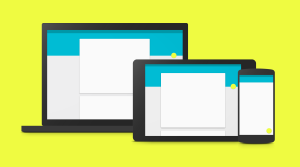

View Case Study
An approach to cross-product, cross-platform design using tangible surfaces, bold graphic design, and meaningful motion.
When we started building for the first mobile devices, mobile meant less: less screen space, slower connection, fewer features. A mobile experience was often a lesser experience. But mobile devices have evolved—they have become more powerful, faster, and more intuitive—so must our approach to design. We challenged ourselves to create a visual language for our users that synthesizes the classic principles of good design with the innovation and possibility of technology and science. We called it material design. A material metaphor is the unifying theory of a rationalized space and a system of motion. Our material is grounded in tactile reality, inspired by our study of paper and ink, yet open to imagination and magic. In material design, surface and shadow establish a physical structure to explain what can be touched and what can move. Content is front and center, using principles of modern print design. Motion is meaningful, clarifying relationships and teaching with delightful details. And as Google, including the Android platform, expands into new form factors, we’re using this design to bridge devices across mobile, desktop, and beyond. At Google I/O, we introduced material design to the public. We needed something that felt at home on the smallest watch, the largest TV, and every screen in between. We used it for Android Wear, our project to extend Android wearables, as well as Android TV, and Android Auto. So as developers and designers create applications and services for this expansive new range of devices, we’re building one unified set of style guidelines that works across any platform. An initial draft of these guidelines is available on google.com/design. This is a first step; we recognize that design is never finished, only built upon by better design. We believe a design system should be consistent, coherent, but not static. Material design will grow and evolve.
- Live Project Link: http://www.google.com/design/spec/material-design/introduction.html
- Why this project is worthy of a UX Award:
Material design represents three major achievements: - The definition of a consistent design system for a large organization, its multiple platforms, and the developers on those platforms. - The clarification of a flexible middle ground between realism and minimalism, taking the essence of tangibility and balancing it with clean, classic design. - The creation of a unique approach to uniting design disciplines with engineering through a shared material metaphor. The scope is unprecedented, tackling the broad set of Google platforms—Android, Chrome, Web, and others—and screen sizes ranging from mobile to desktop, wearables to television. Additionally, the needs of third parties have been considered from the beginning, allowing apps to convey their core functionality and branding across a constellation of devices. This effort provides a rich set of design assets, visual and motion resources, and a new way of thinking about application design that is scalable and intuitive. The design is itself unique, tackling the timely questions of realism and minimalism. It distills and blends the best of both, with material form and shading defining the interaction and a modern, print-like design for content. Refined typography, geometric iconography, bold use of color, and rich imagery are individually considered and then combined, leading to a simple, beautiful design. The final achievement is subtle and important: the material metaphor provides a shared language for our design and engineering disciplines. The use of a material makes it possible to evaluate motion and visual design according to a set of principles based on real behaviors, leading to convergent aesthetic choices. Further, interaction design is reinforced by motion, providing transitory indications of functionality that encourage simple gestural navigation. This facilitates implementation, with a common set of physical laws and rendering systems that make polish and refinement the norm. Each of these achievements is important, but it is the unification of the three—of platform, of styles, and of disciplines—that makes material design exceptional. By providing a seamless experience across platforms, we invite users to move effortlessly between devices, learn continuously, and enjoy simple, delightful experiences everywhere.
- Submitted By: Google, Inc
See More 2014 Submissions >>